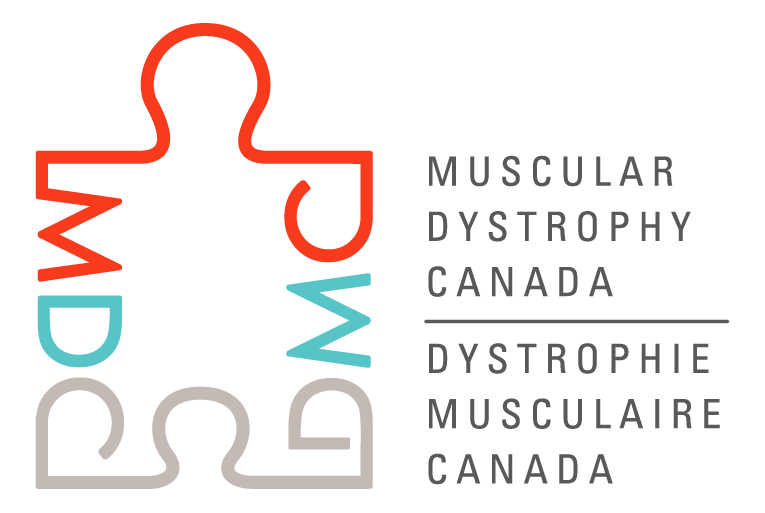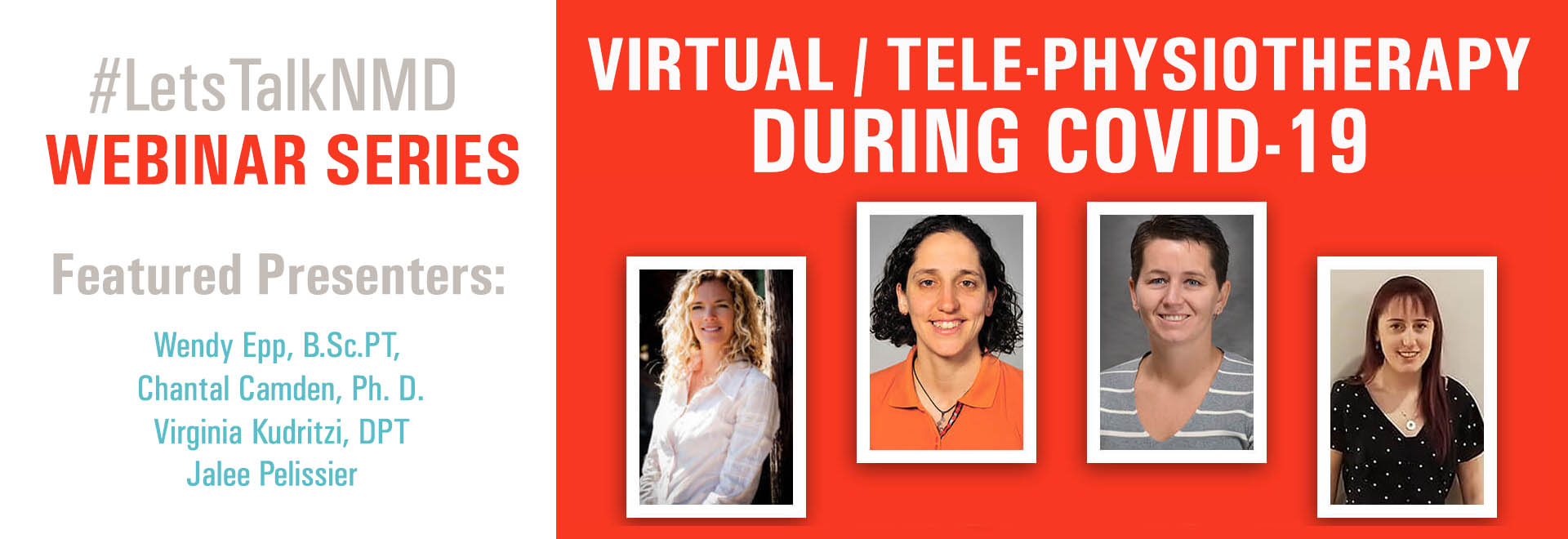
Virtual/Tele-Physiotherapy During COVID-19
Learning Objectives
- Learn about virtual/tele-physiotherapy and understand whether it can be effective.
- Learn about the importance of continuing physical therapy/rehabilitation and the need to transition to virtual rehabilitation during COVID-19.
- Learn about available rehabilitation resources and home-based exercise techniques that are relevant for people with neuromuscular disorders.
- Learn about practical easy-to-use virtual-physiotherapy activities that you can work on during self-isolation.
- Learn how others with neuromuscular disorders are keeping up with physical therapy during self-isolation.
Presenters
WENDY EPP, B.SC.PT, DIPLOMA SPORT PHYSIOTHERAPY – FORM PHYSIOTHERAPY (BRITISH COLUMBIA):
 Wendy is a function-based physiotherapist who uses assessment tools and movement strategies to help patients in a wide array of sports including, but not limited to; triathlon, running, cycling, skiing, and baseball. Wendy helps these athletes (both amateur and professional) return to sport, recreation and competition. A unique and effective feature of Wendy’s delivery of care is her use of video feedback as a tool to achieve a level of understanding and movement knowledge in her patients of all ages.
Wendy is a function-based physiotherapist who uses assessment tools and movement strategies to help patients in a wide array of sports including, but not limited to; triathlon, running, cycling, skiing, and baseball. Wendy helps these athletes (both amateur and professional) return to sport, recreation and competition. A unique and effective feature of Wendy’s delivery of care is her use of video feedback as a tool to achieve a level of understanding and movement knowledge in her patients of all ages.
CHANTAL CAMDEN, Ph.D. – Sherbrooke University (Quebec):
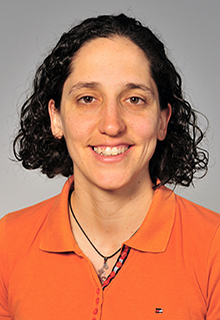 Dr. Camden is an Associate Professor at the School of Rehabilitation at Sherbrooke University. She is a physiotherapist by background and completed her PhD in Rehabilitation Sciences from the University of Montréal and her post-doctoral training at CanChild. Her research focuses on developing, implementing and evaluating evidence-based interventions and service delivery models for children with developmental delays or disabilities. She is also involved in using multi-modal web-based services to develop Tier 1 services.
Dr. Camden is an Associate Professor at the School of Rehabilitation at Sherbrooke University. She is a physiotherapist by background and completed her PhD in Rehabilitation Sciences from the University of Montréal and her post-doctoral training at CanChild. Her research focuses on developing, implementing and evaluating evidence-based interventions and service delivery models for children with developmental delays or disabilities. She is also involved in using multi-modal web-based services to develop Tier 1 services.
VIRGINIA KUDRITZI, DPT – Seattle Veteran’s Hospital (USA):
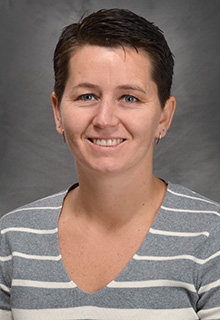 Dr. Virginia Kudritzki is a native Californian who received her Bachelor of Science in Kinesiology from San Francisco State University and her Doctorate in Physical Therapy at the University of Montana, Missoula. Devoted to caring for Veterans, she has worked her entire career at the Seattle Veteran’s Hospital. Virginia has 11 years of experience caring for persons with neuromuscular disease in both inpatient and outpatient settings. Her professional interest lies in promoting safe exercise and mobility for persons with neurological and neuromuscular disease. She is currently collaborating on a grant focused on expanding telehealth-based physical therapy to persons with neuromuscular disease. Virginia currently is the lead physical therapist on the Seattle VA MS and ALS interdisciplinary teams.
Dr. Virginia Kudritzki is a native Californian who received her Bachelor of Science in Kinesiology from San Francisco State University and her Doctorate in Physical Therapy at the University of Montana, Missoula. Devoted to caring for Veterans, she has worked her entire career at the Seattle Veteran’s Hospital. Virginia has 11 years of experience caring for persons with neuromuscular disease in both inpatient and outpatient settings. Her professional interest lies in promoting safe exercise and mobility for persons with neurological and neuromuscular disease. She is currently collaborating on a grant focused on expanding telehealth-based physical therapy to persons with neuromuscular disease. Virginia currently is the lead physical therapist on the Seattle VA MS and ALS interdisciplinary teams.
JALEE PELISSIER (Ontario):
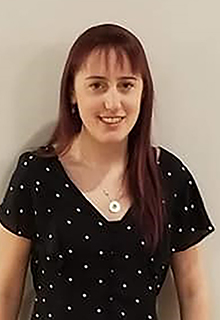 Jalee is a physiotherapy /occupational-therapy aide/assistant living with a neuromuscular disorder (Charcot-Marie-Tooth Syndrome). She attended College Boreal in Sudbury for the Occupational Therapy & Physical Therapy Assistant program. Jalee wants to help others stay motivated and active during this time. Jalee is a long-time supporter of MDC and was the ambassador for the 2019 Muscular Dystrophy Canada North Bay and area walk.
Jalee is a physiotherapy /occupational-therapy aide/assistant living with a neuromuscular disorder (Charcot-Marie-Tooth Syndrome). She attended College Boreal in Sudbury for the Occupational Therapy & Physical Therapy Assistant program. Jalee wants to help others stay motivated and active during this time. Jalee is a long-time supporter of MDC and was the ambassador for the 2019 Muscular Dystrophy Canada North Bay and area walk.
Talk Takeaways
- Tele-rehabilitation is the delivery of rehabilitation services from a distance using the phone, Internet or videoconferencing equipment. Services may include consultation, mentoring, education, support, treatment monitoring, wheelchair prescription, functional assessment, home hazard assessment, and/or therapy.
- Since the COVID-19 pandemic has restricted access to in-person services, many individuals with NMDs have completely stopped physiotherapy. Do not delay any further: time lost is lost momentum. There are an abundant of PT services that can offered through a tele-PT visit. Tele-physiotherapy can be an opportunity for you to learn new skills in your own home using things around your home (e.g., soup can or milk jugs as weights).
- In general terms, research on physiotherapy shows that exercise is safe and important for individuals with NMDs. Tele-physiotherapy may delay or prevent secondary conditions such as obesity, osteoporosis, contractures, or deformities. It can also help improve sleepiness and help you cope better with pain. Tele-physiotherapy improves functional independence, cognition and mental well-being.
(Caveat – exercise is safe and important but you should be cleared by a doctor and the exercise should be prescribed by a licensed physiotherapist.) - Tele-physiotherapy are more effective when coaching techniques/approaches are used. A tele-PT visit can involve the PT coaching a family member or formal caregiver on how to help you stretch, perform a particular exercise, modify or use equipment, etc.
- If you are cleared, ‘sit to stand’ exercises are effective and simple to perform at home. You can use a chair or wheelchair. Please remember whichever home-based exercise you use, be safe and give yourself adequate rest between sets and as much as you need.
